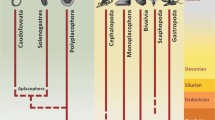Summary
The model of growth of the populations of cells within and immediately surrounding the main lateral nerve cords in the actively growing, immatureDiphyllobothrium dendriticum was studied by the use of3H-thymidine autoradiography. The population of nerve cells within the nerve cord grows only on account of cell migration from the surrounding parenchyma. No mitotic figures were observed in the nerve cords. The rate of growth is high. Within a period of cultivation for 2 days in hamster 34% of the nerve cells within the nerve cords have arrived from the parenchyma. These cells can be considered as cells at the starting point for differentiation into nerve cells. The protective layer of binding cells around the nerve cords also grows on account of cells migrating from the parenchyma. The binding cells actively move from the outer regions of the layer inwards close to the nerve cord.
As stem cells for these types of cell differentiation serve the highly basophilic, actively dividing germinative cells.
Similar content being viewed by others
References
Bråten, T.: Studies of the helminth fauna of Norway. VII. Growth, fecundity, and fertility ofDiphyllobothrium norvegicum Vik, (Cestoda) in golden hamsters. Nytt Mag. Zool.13, 39–51 (1966).
Bullock, T. H., Horridge, G. A.: Structure and function in the nervous system of invertebrates, Vol. I. San Francisco: W. H. Freeman 1965
Bylund, G. B.: Experimental investigations onDiphyllobothrium dendriticum (=D. norvegicum) from Northern Finland. In Swedish with English summary. Parasit. Inst. Soc. Sci. Fenn. Inform.10, 3–17 (1969).
Gustafsson, M. K. S.: The histology of the neck region of plerocrrcoids ofTriaenophorus nodulosus (Cestoda, Pseudophyllidea). Acta zool. fenn.138, 1–16 (1973).
Gustafsson, M. K. S.: Basic cell types inEchinococcus granulosus. (In press)
Hyman, L. H.: The invertebrates: Platyhelminthes and rhynchocoela. The acoelomate bilateria, Vol. II. New York-Toronto-London: McGraw-Hill Book Co. Inc. 1951.
Kralj, N.: Morphologic and histochemical studies on the nervous system of tapeworms revealed by the cholinesterase method (Taenia hydatigena, Dipylidium caninum andMoniezia expansa). Vet. Arh. (Zagreb)37, 277–286 (1967).
Lee, D. L., Rothman, A. H., Sentura, J. B.: Esterases inHymenolepis andHydatigera. Exp. Parasit.14, 285–295 (1963)
Morseth, D. J.: Observations on the fine structure of the nervous system ofEchinococcus granulosus. J. Parasit.53, 492–500 (1967).
Öhman-James, C.: Histochemical studies of the cestodeDiphyllobothrium dendriticum Nitzsch, 1824. Z. Parasitenk.30, 40–56 (1968)
Rees, G.: Nerve cells inAcanthobothrium coronatum (Rud.) (Cestoda: Tetraphyllidea). Parasitology56, 45–54 (1966).
Rees, G., Williams, H. H.: The functional morphology of the scolex and the genitalia ofAcanthobothrium coronatum (Rud.) (Cestoda: Tetraphyllidea). Parasitology55, 617–651 (1965)
Schardein, J. L., Waitz, J. A.: Histochemical studies of esterases in the cuticle and nerve cords of four cyclophyllidean cestodes. J. Parasit.51, 356–363 (1965)
Shield, J. M.:Dipylidium caninum, Echinococcus granulosus andHydatigera taeniformis: Histochemical identification of cholinesterases. Exp. Parasit.25, 217–231 (1969)
Shield, J. M.: Histochemical localization of monoamines in the nervous system ofDipylidium canium (Cestoda) by the formaldehyde flourescence technique. Int. J. Parasit.1, 135–138 (1971)
Tower, W. L.: The nervous system in the cestodeMoniezia expansa. Zool. Jb. Anat.13, 359–384 (1900)
Wardle, R. A., McLeod, J. A.: The zoology of tapeworms. Minneapolis: University Minnesota Press 1952
Wikgren, B.-J.P.: Aspects on the kinetics of the cell population in cestodes. In: H. Teir, T. Rytömaa, eds. Control of cellular growth in adult organisms. New York and London: Academic Press 1967
Wikgren, B.-J. P., Gustafsson, M. K. S.: Duration of the cell cycle of germinative cells in plerocercoids ofDiphyllobothrium dendriticum. Z. Parasitenk.29, 275–281 (1967)
Wikgren, B.-J. P., Gustafsson, M. K. S.: Cell proliferation and histogenesis in diphyllobotriid tapeworms (Cestoda). Acta Acad. Aboensis (B)31, 1–10 (1971)
Wikgren, B.-J. P., Gustafsson, M. K. S., Knuts, G. M.: Primary analage formation in diphyllobithriid tapeworms. Z. Parasitenk.36, 131–139 (1971)
Wikgren, B.-J. P., Knuts, G. M.: Growth of the subtegumental tissue in cestodes by cell migration. Acta Acad. Aboensis (B)30, 1–6 (1970)
Wilson, V. C. L. C., Schiller, E. L.: The neuroanatomy ofHymenolepis diminuta andH. nana. J. Parasit.55, 261–270 (1969).
Author information
Authors and Affiliations
Rights and permissions
About this article
Cite this article
Gustafsson, M.K.S. Observations on the histogenesis of nervous tissue inDiphyllobothrium dendriticum Nitzsch, 1824 (Cestoda, Pseudophyllidea). Z. F. Parasitenkunde 50, 313–321 (1976). https://doi.org/10.1007/BF02462975
Received:
Issue Date:
DOI: https://doi.org/10.1007/BF02462975




